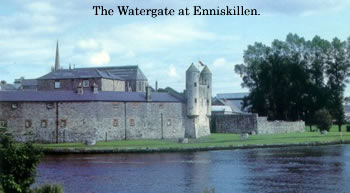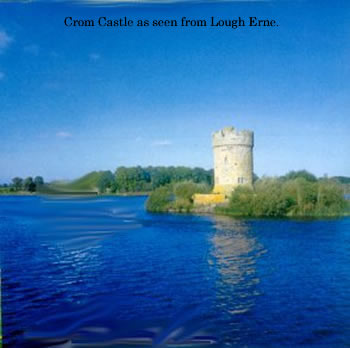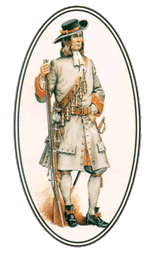Enniskillen - The Guerilla Campaign
Most Ulster folk can tell the inquirer about the Boyne and
the Siege of Derry, but fewer are able to relate the events
which took place at Enniskillen and Aughrim. The sterling
qualities of the Derry men were manifested in their fortitude
while passing through severe trials, and in their patient
endurance of conditions involving hunger and suffering and
death.
 The
virtues of the Enniskilleners were cast in a different mould
and displayed in different forms. The basis of the force was
composed of inhabitants of the town who took up arms for self
defence. They were joined by a large number of the yeomen
of County Fermanagh. Subsequently reinforcements came from
Cavan, Monaghan, Donegal, Leitrim and Sligo; but the force
was essentially local and exclusively Protestant, and all
were known by the general name of the Enniskillen Men. The
virtues of the Enniskilleners were cast in a different mould
and displayed in different forms. The basis of the force was
composed of inhabitants of the town who took up arms for self
defence. They were joined by a large number of the yeomen
of County Fermanagh. Subsequently reinforcements came from
Cavan, Monaghan, Donegal, Leitrim and Sligo; but the force
was essentially local and exclusively Protestant, and all
were known by the general name of the Enniskillen Men.
A copy of the anonymous letter to Lord Mount-Alexander, announcing
the intended massacre of the Protestants, reached them on
the day Derry closed its gates against the Redshanks (7th
December 1688). On the 11th December, a letter was received
from the Government authorities in Dublin, directing them
to make arrangements for having two companies of infantry
quartered in their town. It was an unusual thing to have a
garrison planted among them, and the probability, as they
believed, was, that the day for cutting their throats was
only postponed until everything was ready.
While the town was in a state of uncertainty as to what ought
to be done, three men, William Browning, Robert Clarke, and
William MacCarmick, to whom were soon afterwards added James
Ewart and Allen Cathcart, came together. They resolved to
refuse admittance to the soldiers, whatever consequences might
ensue. The Prince of Orange, as they knew, had landed in England
some five weeks before. Civil war was imminent in Ireland.
North and South most likely would be pitted against each other;
and it appeared to them that, by refusing to admit the troops,
they might be able, not only to protect themselves, but to
hold the most important town between Connaught and Ulster,
it was nevertheless a mad resolve, in the face of the facts.
Arrayed against them was the whole power of the Irish Government,
and that all the means of resistance Enniskillen had was ten
pounds of powder, twenty firelocks, and eighty men. The five
men, however, did resolve, sent notice of their determination
to the surrounding country, craved its assistance, set carpenters
at work on the drawbridge, in connection with the stone bridge
latterly erected at the east end of the town, and, like men
in earnest, took every step that they could think of to increase
their power of resistance.
On the 16th, the news came that the two foot companies sent
by Tyrconnell, had reach Lismella, only four miles from the
town. The townsmen, took up arms, and put themselves in array.
Notwithstanding all the help sent them by the country, their
whole strength did not exceed two hundred foot, and one hundred
and fifty horse, ill-armed, and with no military training
or experience. They left town with the intention of persuading,
if possible, the soldiers to return, but prepared, if necessary,
to resist their entrance. No sooner did the soldiers come
in view of the Enniskilleners than, without waiting for their
approach, they turned and fled.
During the remaining part of 1688 little was done at Enniskillen
except to break the ice around the town, which during that
winter was so thick as to permit men on horseback to cross
Lough Erne in safety and which to some extent imperiled the
safety of the little garrison that was protected by no walls
save walls of water.
Early in 1689 Hamilton, now the Governor of Enniskillen,
formed his men into regiments and fortified the town as best
he could, laying in stores of food, forage and ammunition.
The Enniskilleners resolved "To stand upon our guard
and by the blessing of God, rather to meet our danger than
to expect it."
Crom Castle an outpost of Enniskillen was besieged
by a force of Jacobites under Lord Galmoy. Crom Castle was
under the command of Colonel Crichton. The position of the
castle made it difficult to defend. One saving grace was the
marshy ground, which meant that no heavy siege guns could
be brought near enough to bombard the stronghold. Colonel
Crighton sent a dispatch for help to Governor Hamilton requesting
immediate action so that this outpost could be saved. In the
night Hamilton sent a detachment of 200 of his best armed
men, some by land, some by water, hoping they might enter
Crom Castle under cover of darkness. The reinforcement having
joined those within the walls, they sallied out together,
drove the besiegers from their trenches, and killed about
forty of them. Galmoy at once raised the siege, and retreated.
Flushed with their success at Crom Castle, Hamilton and Lloyd
decided to act as they had resolved to, and went on the offensive.
Intelligence reached Enniskillen that the Irish had placed
a garrison at Trillick, nine miles distant. On the 24th April,
Colonel Lloyd marched against that place. Early intimation,
however, of his approach had been received at Trillick, and
the post was evacuated. Lloyd followed in rapid pursuit, and
after a disorderly retreat of six hours the party dispersed
and took to the bogs. Their baggage and a large number of
cattle were captured. The Castle of Augher, eighteen miles
distant, had been recently occupied by James' party. Early
on the morning of the 28th of April, Lloyd tried to surprise
it, but again the garrison abandoned the post, taking away
with them everything portable. Lloyd, having swept part of
Monaghan and Cavan, returned on the 2nd of May to Enniskillen
with great abundance of sheep, cattle and provisions.
On the 4th May, Ffolliott, the Governor of Ballyshannon,
sent a despatch to Enniskillen, informing Hamilton that a
large body of Jacobites had advanced from Connaught to besiege
his post and begged to be speedily relieved. On the 7th may,
Lloyd proceeded towards Ballyshannon. The besiegers, leaving
a small force to watch the town, advanced three miles to Beleek
to met him. Here they drew up, in a very advantageous position,
their flanks protected on the one side by the lough, and on
the other by a bog of great extent. A narrow causeway formed
the only apparent approach. This they entrenched, and destroyed
the bridge. At a critical moment, a countryman offered to
guide them through the bog. The horse under Captain Acheson
passed in safety, and moved towards their left to turn the
enemy's right flank, and thus cut off their retreat to the
mountains. Before the opposing armies came within shot, the
Irish foot broke and fled to the hills. Their horse, drawn
up to the left of their foot, and between them and the lake,
stood their ground, until charged by the Enniskillen horse,
when, without awaiting the shock, they turned and fled. They
were followed for a great distance, and night alone put an
end to the pursuit. In this encounter the Jacobites lost 190
killed and 60 captured. The victors plundered the enemy camp
and brought all arms, ammunition and two small cannon back
to their island home without losing a man.
When at the end of May there were reports that the Jacobites
had garrisoned Redhill and Ballinacarrig in County Cavan,
Lloyd marched out with 1,600 men to confront the enemy. They
proceeded to drive the enemy out of their strongholds without
firing a shot, using the ploy that they were the vanguard
of a much larger force. They then marched into County Meath
and captured 3,000  head
of cattle, 2,000 sheep and 500 horses and drove them back
to Enniskillen. This sortie of Lloyd's stopped 25 miles from
Dublin and caused a great panic in that city. head
of cattle, 2,000 sheep and 500 horses and drove them back
to Enniskillen. This sortie of Lloyd's stopped 25 miles from
Dublin and caused a great panic in that city.
While Lloyd's raid was taking place, Hamilton captured the
horses belonging to the garrison at Omagh. Cornagrade, which
lies about two miles north-east of Enniskillen was the only
place where Enniskilleners were to taste defeat in the campaign.
The Duke of Berwick roved the country with a flying column
of horse, and his force approached Enniskillen while Lloyd
was meeting Major General Kirke at Lough Swilly to request
help for the newly raised regiments at Enniskillen. Hamilton
sent out insufficent troops to fight and Berwick's men gained
a victory. However, Berwick did not follow up his success.
On the night of the 28th July, a few hours after Colonel
William Wolseley, Lieutenant-Colonel William Berry, Major
Stone, Colonel James Winn, Colonel Tiffan, and other offices
sent by Major-General Kirke, had arrived in Enniskillen, an
express came from Colonel Crighton announcing that Lieutenant-Colonel
MacCarthy (created Lord Mountcashel) had formed a camp at
Crom, with the intention of besieging the castle. Colonel
Wolseley replied that he would provide relief; and he called
in the forces at Ballyshannon, left there by Lloyd, who had
returned to Enniskillen. The Colonel sent Berry to place a
garrison in Lisnaskea; but the castle was in ruins, and he
camped out that night. Next morning he marched his men two
miles nearer the enemy, and, having met a party of Jacobite
soldiers at Conagh, a sharp conflict ensued. The enemy was
completely beaten and pursued for three miles. Berry retired
to the Moat at Lisnaskea, and was joined there by Wolseley
and the rest of the Enniskillen forces.
In the afternoon of the 30th July, Wolseley held a council
of war, and explained to the officers that whatever they resolved
to do should be done quickly, his men having made such haste
to relieve their comrades that they had not brought food with
them. Accordingly, early next morning Wolseley formed his
forces, which numbered two thousand, into three battalions,
heading the main body himself. Lloyd commanded the right and
Tiffan the left wing and marched towards Newtownbutler. Lord
Mountcashel, retreated from Crom to a place between Newtownbutler
and Wattlebridge, where he took up a good position. The foot
occupied a bog, with only one narrow pass, protected by two
cannon. This put the Enniskillen Men at a disadvantage and
the foot regiments of Lloyd and Tiffin were forced to march
through the bog on either side of the path. Presently a man
belonging to Lord Kingston's corps seized a hatchet and killed
seven or eight of those who were guarding the cannon. Wolseley's
horse immediately charged through the Pass; and the Jacobite
horse fled towards Wattlebridge, but were hemmed in by the
Enniskillen horse. The Jacobite foot betook themselves to
the bogs, throwing away their arms, and were pursued all that
night by Enniskilleners, who kept beating the bushes for the
fugitives. Of the Jacobites, 2,000 were killed, 500 jumped
into Lough Erne, and every man except one was drowned. 500
were carried prisoners to Enniskillen, including General Lord
Mountcashel, and a great many officers. Of the 3,600 men who
marched out of Dublin with Mountcashel at their head only
600 returned to the city. The joy of this victory was made
all the sweet when the news of the relief of Derry reached
Enniskillen.
The north was held for King Wiliam and the fate of the Williamite
campaign was determined.
Back to History Home Page
Back to The Williamite
Wars Home Page
|

